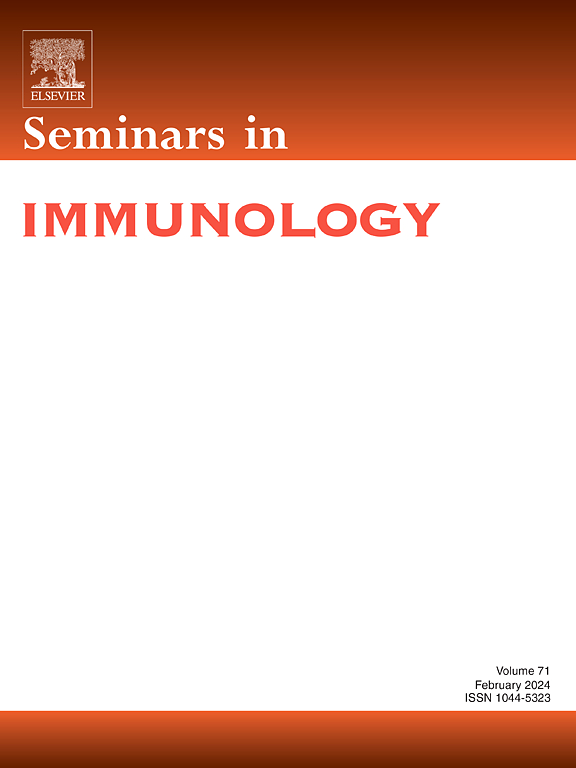凝集素在病原体识别和免疫中的作用的进化观点
IF 7.4
2区 医学
Q1 IMMUNOLOGY
引用次数: 0
摘要
凝集素介导的蛋白-聚糖相互作用对多种生理过程至关重要,包括糖蛋白加工、细胞粘附、通讯、信号传导和免疫识别。凝集素可分为c型、i型、f型和凝集素,它们通过碳水化合物识别结构域(CRDs)识别大分子上的特定聚糖。半乳糖凝集素以其β-半乳糖苷结合和保守的CRD结构为特征,在进化过程中表现出显著的功能多样化。它们最初与发育有关,现在与癌症、血管生成和免疫稳态有关。此外,它们在有益和致病微生物上与聚糖相互作用。当宿主凝集素促进相互作用时,病原体可以利用这种识别来感染并操纵宿主糖基化来破坏凝集素的功能。凝集素识别自我和非自我聚糖的能力,即使在早期后生动物中也很明显,强调了它们的进化多功能性,并提出了关于它们的原始功能和进化轨迹的问题。这篇综述探讨了凝集素的进化作用,强调了它们的适应性和宿主与病原体相互作用之间的复杂相互作用。本文章由计算机程序翻译,如有差异,请以英文原文为准。
An evolutionary perspective of the roles of galectins in pathogen recognition and immunity
Protein-glycan interactions, mediated by lectins, are essential for diverse physiological processes, including glycoprotein processing, cell adhesion, communication, signaling, and immune recognition. Lectins, classified into families like C-type, I-type, F-type, and galectins, recognize specific glycans on macromolecules through their carbohydrate recognition domains (CRDs). Galectins, characterized by their β-galactoside binding and conserved CRD structure, exhibit remarkable functional diversification across evolution. Initially associated with developmental roles, they are now implicated in cancer, angiogenesis, and immune homeostasis. Furthermore, they interact with glycans on both beneficial and pathogenic microorganisms. While host galectins facilitate mutualistic interactions, pathogens can exploit this recognition for infection and manipulate host glycosylation to subvert galectin functions. The ability of galectins to recognize both self and non-self glycans, evident even in early metazoans, underscores their evolutionary versatility and raises questions about their primordial function and their evolutionary trajectory. This review explores the evolving roles of galectins, highlighting their adaptability and the complex interplay between host and pathogen interactions.
求助全文
通过发布文献求助,成功后即可免费获取论文全文。
去求助
来源期刊

Seminars in Immunology
医学-免疫学
CiteScore
11.40
自引率
1.30%
发文量
50
审稿时长
89 days
期刊介绍:
Seminars in Immunology is a specialized review journal that serves as a valuable resource for scientists in the field of immunology. The journal's approach is thematic, with each issue dedicated to a specific topic of significant interest to immunologists. It covers a wide range of research areas, from the molecular and cellular foundations of the immune response to the potential for its manipulation, highlighting recent advancements in these areas.
Each thematic issue is curated by a guest editor, who is recognized as an expert in the field internationally. The content of each issue typically includes six to eight authoritative invited reviews, which delve into various aspects of the chosen topic. The goal of these reviews is to provide a comprehensive, coherent, and engaging overview of the subject matter, ensuring that the information is presented in a timely manner to maintain its relevance.
The journal's commitment to quality and timeliness is further supported by its inclusion in the Scopus database, which is a leading abstract and citation database of peer-reviewed literature. Being indexed in Scopus helps to ensure that the journal's content is accessible to a broad audience of researchers and professionals in immunology and related fields.
 求助内容:
求助内容: 应助结果提醒方式:
应助结果提醒方式:


